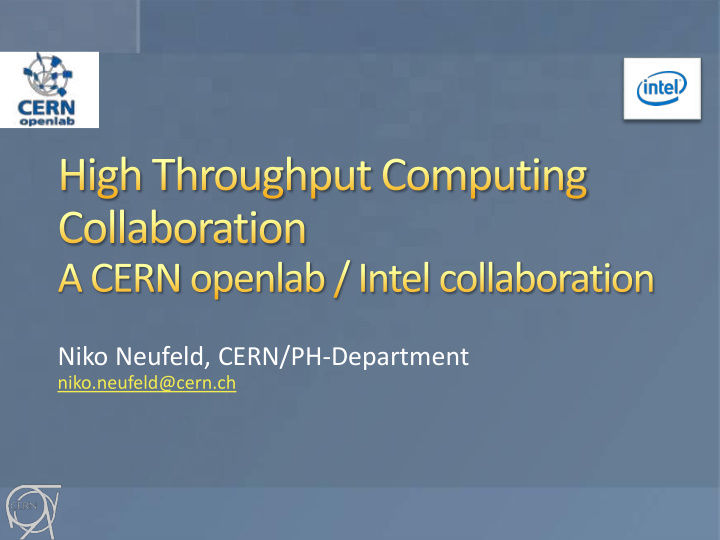



Niko Neufeld, CERN/PH-Department niko.neufeld@cern.ch
Apply upcoming Intel technologies in an Online / Trigger & DAQ context Application domains: L1-trigger, data acquisition and event-building, accelerator-assisted processing for high-level trigger Intel/CERN High Throughput Computing Collaboration 2 openlab Open Day June 2015 - Niko Neufeld CERN
• 15 million sensors • Giving a new value 40.000.000 / second • = ~15 * 1,000,000 * 40 * 1,000,000 bytes • = ~ 600 TB/sec (16 / 24 hrs / 120 days a year) • can (afford to) store about O(1) GB/s Intel/CERN High Throughput Computing Collaboration 3 openlab Open Day June 2015 - Niko Neufeld CERN
1. Thresholding and tight encoding 2. Real-time selection based on partial information 3. Final selection using full information of the collisions S election systems are called “Triggers” in high energy physics Intel/CERN High Throughput Computing Collaboration 4 openlab Open Day June 2015 - Niko Neufeld CERN
A combination of (radiation hard) ASICs and FPGAs process data of “simple” sub -systems with “few” O(10000) channels in real-time Other channels need to buffer data on the detector this works only well for “simple” selection criteria long-term maintenance issues with custom hardware and low-level firmware crude algorithms miss a lot of interesting collisions Intel/CERN High Throughput Computing Collaboration 6 openlab Open Day June 2015 - Niko Neufeld CERN
Intel has announced plans for the first Xeon with coherent FPGA concept providing new capabilities We want to explore this to: Move from firmware to software Custom hardware commodity Rationale: HEP has a long tradition of using FPGAs for fast, online, processing Need real-time characteristics: algorithms must decide in O(10) microseconds or force default decisions (even detectors without real-time constraints will profit) Intel/CERN High Throughput Computing Collaboration 7 openlab Open Day June 2015 - Niko Neufeld CERN
Port existing (Altera ) FPGA based LHCb Muon trigger to Xeon/FPGA Currently uses 4 crates with > 400 Stratix II FPGAs move to a small number of FPGA enhanced Xeon-servers Study ultra-fast track reconstruction techniques for 40 MHz tracking (“track - trigger”) Collaboration with Intel DCG IPAG -EU Data Center Group, Innovation Pathfinding Architecture Group-EU Intel/CERN High Throughput Computing Collaboration 8 openlab Open Day June 2015 - Niko Neufeld CERN
Detector • Pieces of collision data spread out over 10000 10000 x links received by O(100) Readout Units readout-units ~ 1000 x • All pieces must be brought DAQ network together into one of thousands compute units requires very fast, large switching network • Compute units running ~ 3000 x complex filter algorithms Compute Units Intel/CERN High Throughput Computing Collaboration 10 openlab Open Day June 2015 - Niko Neufeld CERN
Rate of collisions Data-size requiring full Required # of / collision processing 100 Gbit/s Aggregated [kB] [kHz] links bandwidth From ALICE 20000 50 120 10 Tbit/s 2019 ATLAS 4000 500 300 20 Tbit/s 2022 CMS 4000 1000 500 40 Tbit/s 2022 LHCb 100 40000 500 40 Tbit/s 2019 Intel/CERN High Throughput Computing Collaboration 11 openlab Open Day June 2015 - Niko Neufeld CERN
Explore Intel’s new OmniPath interconnect to build the next generation data acquisition systems Build small demonstrator DAQ Use CPU-fabric integration to minimise transport overheads Use OmniPath to integrate Xeon, Xeon/Phi and Xeon/FPGA concept in optimal proportions as compute units Work out flexible concept Study smooth integration with Ethernet (“the right link for the right task”) Intel/CERN High Throughput Computing Collaboration 12 openlab Open Day June 2015 - Niko Neufeld CERN
Pack the knowledge of tens of thousands of physicists and decades of research into a huge sophisticated algorithm Several 100.000 lines of code Takes (only!) a few 10 - 100 milliseconds per collision “And this, in simple terms, is how we find the Higgs Boson” Intel/CERN High Throughput Computing Collaboration 14 openlab Open Day June 2015 - Niko Neufeld CERN
Intel/CERN High Throughput Computing Collaboration 15 openlab Open Day June 2015 - Niko Neufeld CERN
Can be much more complicated: lots of tracks / rings, curved / spiral trajectories, spurious measurements and various other imperfections Intel/CERN High Throughput Computing Collaboration openlab Open Day June 2015 - Niko Neufeld CERN 16
Complex algorithms Hot spots difficult to identify cannot be accelerated by optimising 2 -3 kernels alone Classical algorithms very “sequential”, parallel versions need to be developed and their correctness (same physics!) needs to be demonstrated Lot of throughput necessary high memory bandwidth, strong I/O There is a lot of potential for parallelism, but the SIMT-kind (GPGPU-like) is challenging for many of our problems HTCC will use next generation Xeon/Phi (KNL) and port critical online applications as demonstrators: LHCb track reconstruction (“Hough Transformation & Kalman Filtering”) Particle identification using RICH detectors Intel/CERN High Throughput Computing Collaboration 17 openlab Open Day June 2015 - Niko Neufeld CERN
The LHC experiments need to reduce 100 TB/s to ~ 25 PB/ year Today this is achieved with massive use of custom ASICs and in-house built FPGA-boards and x86 computing power Finding new physics requires massive increase of processing power, much more flexible algorithms in software and much faster interconnects The CERN/Intel HTC Collaboration will explore Intel’s Xeon/FPGA concept, Xeon/Phi and OmniPath technologies for building future LHC TDAQ systems Intel/CERN High Throughput Computing Collaboration 18 openlab Open Day June 2015 - Niko Neufeld CERN
Recommend
More recommend